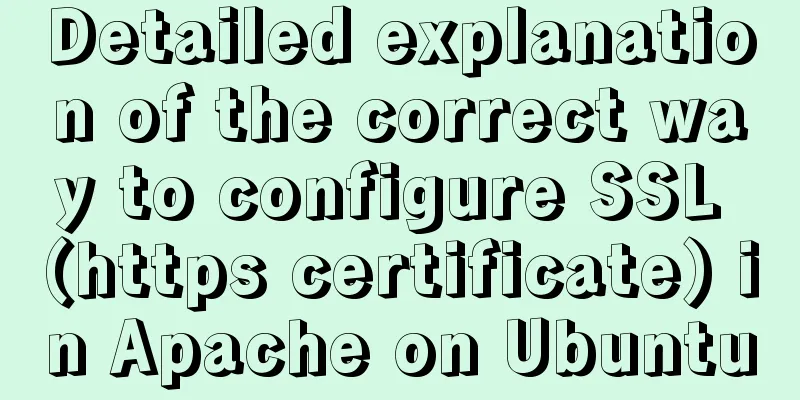Detailed explanation of the correct way to configure SSL (https certificate) in Apache on Ubuntu

|
First, take a look at Alibaba Cloud's official tutorial: File Description: 1. The certificate file xxxxxx.pem contains two sections. Please do not delete any section. 2. If the CSR is created by the certificate system, it also includes: certificate private key file xxxxxxxx.key, certificate public key file public.pem, and certificate chain file chain.pem. (1) Create a cert directory under the Apache installation directory and copy all the downloaded files into the cert directory. If you created the CSR file yourself when applying for the certificate, please put the corresponding private key file in the cert directory and name it xxxxxxxx.key; (2) Open the httpd.conf file in the conf directory under the Apache installation directory, find the following content and remove the "#": #LoadModule ssl_module modules/mod_ssl.so (If it cannot be found, please confirm whether the openssl plug-in has been compiled) #Include conf/extra/httpd-ssl.conf (3) Open the conf/extra/httpd-ssl.conf file in the Apache installation directory (it may also be conf.d/ssl.conf, depending on the operating system and installation method), and search for the following configuration statement in the configuration file: # Add SSL protocol support protocols and remove insecure protocols SSLProtocol all -SSLv2 -SSLv3 # Modify the encryption suite as follows SSLCipherSuite HIGH:!RC4:!MD5:!aNULL:!eNULL:!NULL:!DH:!EDH:!EXP:+MEDIUM SSLHonorCipherOrder on # Certificate public key configuration SSLCertificateFile cert/public.pem # Certificate private key configuration SSLCertificateKeyFile cert/xxxxxxx.key # Certificate chain configuration. If the attribute starts with a '#' character, please delete it. SSLCertificateChainFile cert/chain.pem (4) Restart Apache. (5) Access your site via https to test the installation and configuration of the site certificate. If you encounter certificate distrust issues, please watch the help video. However, this is only for reference. In Ubuntu, I installed Apache using apt, but it does not have an httpd.conf file, only an apache2.conf file. Well, this file is similar to httpd.conf, and it contains the following comments: # It is split into several files forming the configuration hierarchy outlined # below, all located in the /etc/apache2/ directory: # # /etc/apache2/ # |-- apache2.conf # | `-- ports.conf # |-- mods-enabled # | |-- *.load # | `-- *.conf # |-- conf-enabled # | `-- *.conf # `-- sites-enabled # `-- *.conf # This version of Apache spreads the configuration files into other small files, and the structure is as shown above. If you want, you can also write your own httpd.conf and include it. Let's focus on the configuration of https. The first step is to ensure that port 443 of your external environment is open. The second step is to make sure you have ssl_module installed. If not, just apt-get install openssl. Some dependencies may be required, but they are all minor problems. Then open ports.conf, the following sentences are essential: <IfModule ssl_module> Listen 443 </IfModule> <IfModule mod_gnutls.c> Listen 443 </IfModule> Then open mods-available and find ssl.conf and ssl.load ssl.load looks like this:
# Depends: setenvif mime socache_shmcb
LoadModule ssl_module /usr/lib/apache2/modules/mod_ssl.so
ssl.conf looks like this:
<IfModule mod_ssl.c>
# Pseudo Random Number Generator (PRNG):
# Configure one or more sources to seed the PRNG of the SSL library.
# The seed data should be of good random quality.
# WARNING! On some platforms /dev/random blocks if not enough entropy
# is available. This means you then cannot use the /dev/random device
# because it would lead to very long connection times (as long as
# it requires to make more entropy available). But usually those
# platforms additionally provide a /dev/urandom device which doesn't
# block. So, if available, use this one instead. Read the mod_ssl User
# Manual for more details.
#
SSLRandomSeed startup builtin
SSLRandomSeed startup file:/dev/urandom 512
SSLRandomSeed connect builtin
SSLRandomSeed connect file:/dev/urandom 512
##
## SSL Global Context
##
## All SSL configuration in this context applies both to
## the main server and all SSL-enabled virtual hosts.
##
#
# Some MIME-types for downloading Certificates and CRLs
#
AddType application/x-x509-ca-cert .crt
AddType application/x-pkcs7-crl .crl
# Pass Phrase Dialog:
# Configure the pass phrase gathering process.
# The filtering dialog program (`builtin' is an internal
# terminal dialog) has to provide the pass phrase on stdout.
SSLPassPhraseDialog exec:/usr/share/apache2/ask-for-passphrase
# Inter-Process Session Cache:
# Configure the SSL Session Cache: First the mechanism
# to use and second the expiring timeout (in seconds).
# (The mechanism dbm has known memory leaks and should not be used).
#SSLSessionCache dbm:${APACHE_RUN_DIR}/ssl_scache
SSLSessionCache shmcb:${APACHE_RUN_DIR}/ssl_scache(512000)
SSLSessionCacheTimeout 300
# Semaphore:
# Configure the path to the mutual exclusion semaphore the
# SSL engine uses internally for inter-process synchronization.
# (Disabled by default, the global Mutex directive consolidates by default
# this)
#Mutex file:${APACHE_LOCK_DIR}/ssl_mutex ssl-cache
# SSL Cipher Suite:
# List the ciphers that the client is permitted to negotiate. See the
# ciphers(1) man page from the openssl package for list of all available
# options.
# Enable only secure ciphers:
SSLCipherSuite HIGH:!RC4:!MD5:!aNULL:!eNULL:!NULL:!DH:!EDH:!EXP:+MEDIUM
# SSL server cipher order preference:
# Use server priorities for cipher algorithm choice.
# Clients may prefer lower grade encryption. You should enable this
# option if you want to enforce stronger encryption, and can afford
# the CPU cost, and did not override SSLCipherSuite in a way that puts
# insecure ciphers first.
# Default: Off
SSLHonorCipherOrder on
# The protocols to enable.
# Available values: all, SSLv3, TLSv1, TLSv1.1, TLSv1.2
# SSL v2 is no longer supported
SSLProtocol all -SSLv2 -SSLv3
# Allow insecure renegotiation with clients which do not yet support the
# secure renegotiation protocol. Default: Off
#SSLInsecureRenegotiation on
# Whether to forbid non-SNI clients to access name based virtual hosts.
# Default: Off
#SSLStrictSNIVHostCheck On
</IfModule>
# vim: syntax=apache ts=4 sw=4 sts=4 sr noet
Next is the configuration of the site. Here we use the default default-ssl.conf:
<IfModule mod_ssl.c>
<VirtualHost _default_:443>
ServerName
################Add your own site configuration##########
# Available loglevels: trace8, ..., trace1, debug, info, notice, warn,
# error, crit, alert, emerg.
# It is also possible to configure the loglevel for particular
# modules, e.g.
#LogLevel info ssl:warn
ErrorLog ${APACHE_LOG_DIR}/error.log
CustomLog ${APACHE_LOG_DIR}/access.log combined
# For most configuration files from conf-available/, which are
# enabled or disabled at a global level, it is possible to
# include a line for only one particular virtual host. For example the
# The following line enables the CGI configuration for this host only
# after it has been globally disabled with "a2disconf".
#Include conf-available/serve-cgi-bin.conf
# SSL Engine Switch:
# Enable/Disable SSL for this virtual host.
SSLEngine on
# A self-signed (snakeoil) certificate can be created by installing
# the ssl-cert package. See
# /usr/share/doc/apache2/README.Debian.gz for more info.
# If both key and certificate are stored in the same file, only the
# SSLCertificateFile directive is needed.
SSLCertificateFile /etc/apache2/cert/public.pem
SSLCertificateKeyFile /etc/apache2/cert/xxxxxxx.key
# Server Certificate Chain:
# Point SSLCertificateChainFile at a file containing the
# concatenation of PEM encoded CA certificates which form the
# certificate chain for the server certificate. Alternatively
# the referenced file can be the same as SSLCertificateFile
# when the CA certificates are directly appended to the server
# certificate for convinience.
SSLCertificateChainFile /etc/apache2/cert/chain.pem
# Certificate Authority (CA):
# Set the CA certificate verification path where to find CA
# certificates for client authentication or alternatively one
# huge file containing all of them (file must be PEM encoded)
# Note: Inside SSLCACertificatePath you need hash symlinks
# to point to the certificate files. Use the provided
# Makefile to update the hash symlinks after changes.
#SSLCACertificatePath /etc/ssl/certs/
#SSLCACertificateFile /etc/apache2/ssl.crt/ca-bundle.crt
# Certificate Revocation Lists (CRL):
# Set the CA revocation path where to find CA CRLs for client
# authentication or alternatively one huge file containing all
# of them (file must be PEM encoded)
# Note: Inside SSLCARevocationPath you need hash symlinks
# to point to the certificate files. Use the provided
# Makefile to update the hash symlinks after changes.
#SSLCARevocationPath /etc/apache2/ssl.crl/
#SSLCARevocationFile /etc/apache2/ssl.crl/ca-bundle.crl
# Client Authentication (Type):
# Client certificate verification type and depth. Types are
# none, optional, require and optional_no_ca. Depth is a
# number which specifies how deeply to verify the certificate
# issuer chain before deciding the certificate is not valid.
#SSLVerifyClient require
#SSLVerifyDepth 10
# SSL Engine Options:
# Set various options for the SSL engine.
# o FakeBasicAuth:
# Translate the client X.509 into a Basic Authorisation. This means that
# the standard Auth/DBMAuth methods can be used for access control.
# user name is the `one line' version of the client's X.509 certificate.
# Note that no password is obtained from the user. Every entry in the user
# file needs this password: `xxj31ZMTZzkVA'.
# o ExportCertData:
# This exports two additional environment variables: SSL_CLIENT_CERT and
# SSL_SERVER_CERT. These contain the PEM-encoded certificates of the
# server (always existing) and the client (only existing when client
# authentication is used). This can be used to import the certificates
# into CGI scripts.
# o StdEnvVars:
# This exports the standard SSL/TLS related `SSL_*' environment variables.
# Per default this exportation is switched off for performance reasons,
# because the extraction step is an expensive operation and is usually
# useless for serving static content. So one usually enables the
# exportation for CGI and SSI requests only.
# o OptRenegotiate:
# This enables optimized SSL connection renegotiation handling when SSL
# directives are used in per-directory context.
#SSLOptions +FakeBasicAuth +ExportCertData +StrictRequire
<FilesMatch "\.(cgi|shtml|phtml|php)$">
SSLOptions +StdEnvVars
</FilesMatch>
<Directory /usr/lib/cgi-bin>
SSLOptions +StdEnvVars
</Directory>
# SSL Protocol Adjustments:
# The safe and default but still SSL/TLS standard compliant shutdown
# approach is that mod_ssl sends the close notify alert but doesn't wait for
# the close notify alert from client. When you need a different shutdown
# approach you can use one of the following variables:
# o ssl-unclean-shutdown:
# This forces an unclean shutdown when the connection is closed, ie no
# SSL close notify alert is sent or allowed to be received. This violates
# the SSL/TLS standard but is needed for some brain-dead browsers. Use
# this when you receive I/O errors because of the standard approach where
# mod_ssl sends the close notify alert.
# o ssl-accurate-shutdown:
# This forces an accurate shutdown when the connection is closed, ie a
# SSL close notify alert is sent and mod_ssl waits for the close notify
# alert of the client. This is 100% SSL/TLS standard compliant, but in
# practice often causes hanging connections with brain-dead browsers. Use
# this only for browsers where you know that their SSL implementation
# works correctly.
# Notice: Most problems of broken clients are also related to the HTTP
# keep-alive facility, so you usually additionally want to disable
# keep-alive for those clients, too. Use variable "nokeepalive" for this.
# Similarly, one has to force some clients to use HTTP/1.0 to workaround
# their broken HTTP/1.1 implementation. Use variables "downgrade-1.0" and
# "force-response-1.0" for this.
# BrowserMatch "MSIE [2-6]" \
# nokeepalive ssl-unclean-shutdown \
# downgrade-1.0 force-response-1.0
</VirtualHost>
</IfModule>
# vim: syntax=apache ts=4 sw=4 sts=4 sr noet
Did you notice that the configuration items in the Alibaba Cloud tutorial are divided into two configuration files? Then use https to access it on the browser, it is successful. (Linux can use wget or curl to test) The above is the full content of this article. I hope it will be helpful for everyone’s study. I also hope that everyone will support 123WORDPRESS.COM. You may also be interested in:
|
<<: Solve the problem that the element DateTimePicker+vue pop-up box only displays hours
>>: How to sort a row or column in mysql
Recommend
Getting Started Tutorial on Using TS (TypeScript) in Vue Project
Table of contents 1. Introducing Typescript 2. Co...
A brief discussion on common operations of MySQL in cmd and python
Environment configuration 1: Install MySQL and ad...
MySQL 8.0.17 installation and simple configuration tutorial under macOS
If you don’t understand what I wrote, there may b...
What does it mean to add a question mark (?) after the CSS link address?
For example: <link rel="stylesheet" h...
Fabric.js implements DIY postcard function
This article shares the specific code of fabricjs...
Docker solution for logging in without root privileges
When you use the docker command for the first tim...
Nginx rtmp module compilation arm version problem
Table of contents 1. Preparation: 2. Source code ...
Docker FAQ
Docker only maps ports to IPv6 but not to IPv4 St...
Standard summary for analyzing the performance of a SQL statement
This article will introduce how to use explain to...
The most commonly used HTML escape sequence
In HTML, <, >, &, etc. have special mean...
Summary of CSS3 practical methods (recommended)
1. Rounded border: CSS CodeCopy content to clipbo...
Share CSS writing standards and order [recommended for everyone to use]
CSS writing order 1. Position attributes (positio...
Installing Win10 system on VMware workstation 14 pro
This article introduces how to install the system...
How to unify the character set on an existing mysql database
Preface In the database, some data tables and dat...
MySQL Server 8.0.13.0 Installation Tutorial with Pictures and Text
Install 8.0.13 based on MySQL 6.1.3. MySQL 8.0.13...









